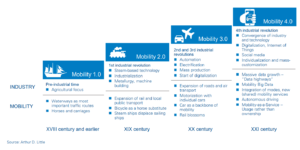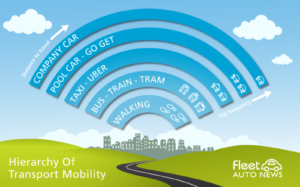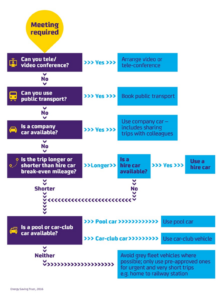 The future of mobility provides challenges and opportunities for businesses to reset how mobility is managed between employers and employees, suppliers, partners, neighbours and between businesses, consumers, and governments.
The future of mobility provides challenges and opportunities for businesses to reset how mobility is managed between employers and employees, suppliers, partners, neighbours and between businesses, consumers, and governments.
Mobility outlook for a businesses
Around the world there is a fundamental mobility shift occurring, led by technological and social changes, in how people and goods move from point A to B. The shift is a convergence of industry, technology and data in a move to shared mobility services, and increasingly viable electric vehicles that are connected and ultimately autonomous. [1] This shift from an ownership-based economy to an access-based economy will impact across industries including those outside of the traditional automotive market as they innovate and accommodate new social and commercial behaviours in movement in a 4th Industrial Revolution. [2]
The global demand for passenger mobility in urbanised areas is set to double by 2050, and the number of individual journeys taken on a daily basis has grown massively since 2015, putting increased pressure on existing urban mobility systems.
Freight and logistics mobility
Freight and logistics mobility is also undergoing significant change, driven by online and mobile shopping, technology advancements with automated vehicles, distributed production, 3D printing and drones.
Online and mobile shopping has changed how Australian businesses manage their supply chains, micros freight, inventory availability and shipping times impacting purchasing decisions and supply chain networks. In Sydney light commercial vehicles, or delivery vans, make up about 15% of traffic, which is about 6% more than heavy freight vehicles. [3]

The 4th industrial revolution Source: Little, A. D. [2]
Business opportunities
This mobility transformation presents many challenges for business, but also serves up opportunities such as coordination and collaboration with neighbouring business. Collaboration between business to form mobility infrastructure hubs, such as car park and bike parking, electric vehicle charging points, on-demand shuttle buses can share costs and accelerate uptake.
Coordinating and strong communication with councils on business mobility plans early allows for incorporation of location wide mobility options and infrastructure. For example, if your business is planning to rollout a bike share scheme, then share this with your local council so that they can support these plans with council operative infrastructure like bike paths.
Ownership and leasing
Mobility disruption’s role on fleet management is predicted to change the ownership and leasing ecosystem, with predictions management companies operating more broadly across shared fleet services. In Australia 419,000 businesses currently operate a fleet, owning and leasing almost 3.5 million vehicles. While traditional transportation options are still the preference, more recent entrants to the market such as car sharing (e.g. GoGet, Flexicar, DriveMyCar), and rideshare (e.g. Uber for Business, DiDi, Ola) are changing the fleet mix.
A third of companies with a business fleet currently use ride share, and many expect to increase their utilisation further in the coming years. [4] Usage currently skews to metro areas but operators are continuing to expand their operations to cover regional locations. The NSW Department of Industry was instrumental in bringing car sharing to country Orange through new fleet policies that included car sharing.
Freight and logistics
Electric vehicle technology has the potential to provide significant benefits to operators of freight vehicles, including light commercial vans and heavy trucks. The freight logistics industry is servicing a growing demand for road freight, and the cost efficiency and environmental performance of freight operators will help improve freight productivity. [5]
Recent analysis from Europe suggests around one- quarter of all truck kilometres were run empty. A range of options are available for consolidating loads, including vehicle design, shared distribution and online load matching services, enabling operators to search for available backloads. [6]
Another way of moving towards more sustainable freight and logistics is shifting commercial deliveries to off-peak hours. Goods transport accounts for almost 20% of urban congestion, so by allowing night deliveries stop-and-go commercial vehicles are taken off the streets during the day. [7]
Read more about freight and logistics in our EV trucks article.
Employee mobility
A travel hierarchy is a good place to start thinking about integrating sustainable, multi-modal mobility for work travel.
A transport hierarchy developed by Fleet Auto News suggests walking and public transport should be considered for short journeys regardless of frequency. For longer infrequent trips a taxi could be the best option. And then car sharing or pool cars for regular long distance travel. A company vehicle should be the last option when the distance travelled each year is high and business utilisation is close to 100%. [8]

Source: Fleet Auto News
Energy Savings Trust from the UK has a good travel hierarchy that is also useful to determine the mode of transport for employee travel. [9]

Source: Energy Savings Trust [10]
Customer mobility
According to OECD (Organisation for Economic Co-operation and Development) International Transport Forum, for most businesses, mobility initiatives targeting customers and visitors are very similar for those aimed at employee journey-to-work, in end-of-trip infrastructure, incentivisation and information provision. [11]

